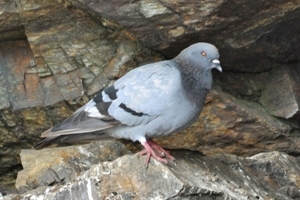The rock dove
 If you take a walk through any sizeable town in the UK, you are sure to come across “feral” pigeons of assorted colours, busily pecking around your feet for scraps, or sitting in groups on various vantage points high up on buildings. The Trafalgar Square pigeons in London became world famous, attracting thousands of visitors to the square to have their photo taken with pigeons perched all over them!
If you take a walk through any sizeable town in the UK, you are sure to come across “feral” pigeons of assorted colours, busily pecking around your feet for scraps, or sitting in groups on various vantage points high up on buildings. The Trafalgar Square pigeons in London became world famous, attracting thousands of visitors to the square to have their photo taken with pigeons perched all over them!
However, these birds were certainly not loved by everyone as they left piles of guano on buildings, deposited droppings onto smartly dressed city workers, and generally became rather a nuisance as they flapped around people in marauding flocks!
This all came to head in 2000, when London’s Mayor Ken Livingstone caused rather a stir by declaring war on Trafalgar Square’s pigeons. He banned the traditional sale of corn on the square in an attempt to starve the flock out of existence. It did not really work particularly well though as people leapt to the birds defence, creating Save The Trafalgar Square Pigeons (STTSP) to fight for these Townie pigeons!
The ancestor of all these feral pigeons (and domesticated pigeons, of which Darwin counted 228 distinct varieties), are the 'pure' rock doves, which were found all around the coastline of Britain, nesting on cliff ledges and within caves. Nowadays, these genuinely wild “pure” rock doves are restricted to the extreme far northwest of Scotland, with strongholds on Shetland, Orkney and North Uist. Wild rock doves are pale grey with two black bars on each wing, while domestic and feral pigeons are very variable in colour and pattern, although many still retain the distinctive black bars.
Rock doves were “domesticated” for many different reasons, with dovecots being commonplace by the late 16th Century, the birds being bred to provide eggs and meat. Fancy pigeon breeders have gone on to create hundreds of varieties that look dramatically different to their original rock-dwelling ancestors. Now you can come across pigeons with long legs that are feathered all the way down to the feet, birds with huge fan tails, and of course plumage of just about every colour imaginable! Birds were specifically bred to race for sport, these same birds being also commandeered to carry important messages in both world wars.
Darwin was fascinated by how one species could be manipulated to such extremes. From his travels on HMS Beagle, Darwin suspected that the environment might naturally manipulate species, causing them to change over time, but he couldn't find a means to explore this effectively in the wild. But he could see that pigeon breeders who were experimenting with artificial selection, gave him a way to study how far a species could change.
The similarity between artificial selection and natural selection is at the heart of Darwin's explanation of evolution in his revolutionary book, On the Origin of Species (1859). Although he went on to study his famous wild finches, the pigeon was the first creature that he discussed in detail.
So, remember when you next see a Townie pigeon sitting on its artificial rock face ledge high up on a building, or a fancy pigeon strutting around fanning out its tail or a flock of racing pigeons charging past in a hurry to get home – that they all originated from just one species, the humble rock dove (Columbia livia).
Peter Thompson
Advisory
Read more from Peter Thompson at the Fresh from the Field blog.

Download Peter Thompson's essential 26-page book, featuring beautiful photography and detailed profiles of Britain's wildlife
Download FREE >